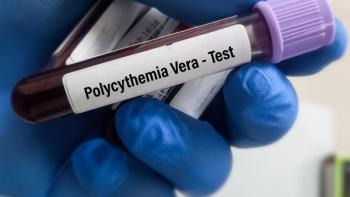
Rina-S Earns Breakthrough Designation in Advanced Endometrial Cancer
Key Takeaways
- Rina-S has received FDA breakthrough therapy designation for advanced endometrial cancer after standard treatments fail, based on promising Phase 1/2 trial results.
- The RAINFOL-01 trial showed significant objective response rates in heavily pretreated patients, with long-lasting responses and manageable side effects.
Rina-S earned breakthrough therapy designation for patients with advanced endometrial cancer whose disease has worsened after platinum-based chemotherapy.
The U.S. Food and Drug Administration (FDA) has granted breakthrough therapy designation to rinatabart sesutecan (Rina-S), an investigational antibody-drug conjugate (ADC), for patients with advanced endometrial cancer whose disease has worsened after platinum-based chemotherapy and PD-(L)1 immunotherapy, according to a news release from Genmab.
The designation is based on results from the ongoing Phase 1/2 RAINFOL-01 trial, which is evaluating Rina-S as a single-agent treatment.
Breakthrough therapy designation is intended to speed the development and review of therapies that may significantly improve outcomes for patients facing serious or life-threatening conditions. For women with advanced or recurrent endometrial cancer, current options are limited once standard treatments fail, and prognosis is often poor.
“This breakthrough therapy designation underscores the future potential of Rina-S as a treatment option for women diagnosed with advanced endometrial cancer, who face a poor prognosis after progressing on standard of care treatment,” said Dr. Judith Klimovsky, executive vice president and chief development officer at Genmab.
RAINFOL-01 Trial Results Show Responses With Rina-S in Advanced Endometrial Cancer
Data from cohort B2 of the
Patients treated in the 100 mg/m2 group (22 patients) achieved a 50% confirmed objective response rate (ORR), including two complete responses. The median duration of response was not reached after a median follow-up of 7.7 months, suggesting responses may be long-lasting.
In the 120 mg/m2 group (42 patients), the confirmed ORR was 47.1%, and the median duration of response was also not reached after a median follow-up of 9.8 months. On average, patients had previously received three lines of therapy (ranging from one to eight).
“These phase 1/2 results demonstrate encouraging data with Rina-S in this patient population and support its further development as a potential therapy for patients with advanced and recurrent endometrial cancer,” said Dr. Ira Winer, study investigator and professor of gynecologic oncology at the Karmanos Cancer Institute, Wayne State University.
Moreover, treatment with Rina-S was generally well tolerated. The most common side effects (all grades) included diarrhea, shortness of breath, urinary tract infections, headache, constipation, decreased appetite, fatigue, nausea and vomiting.
Serious side effects of grade 3 (severe) or higher occurred in 31.8% of patients in the 100 mg/m2 group and 50% in the 120 mg/m² group. Importantly, hematologic side effects were manageable, with low rates of treatment discontinuation. Unlike some other ADCs, Rina-S was not linked to eye problems, nerve damage or interstitial lung disease — toxicities that can limit use of other drugs in this class.
How Rina-S Targets Folate Receptor Alpha in Endometrial Cancer Treatment
Rina-S is designed to target folate receptor alpha (FRα), a protein that is often overexpressed on endometrial tumors. It links a monoclonal antibody to exatecan, a chemotherapy payload, using a cleavable linker. Once bound to cancer cells, the drug is taken inside the cell, where it releases the chemotherapy agent to kill the tumor from within.
“Testing for FRα is now part of our standard of care testing, and really that should be considered. [I do this] in my clinical practice for anyone with a recurrence; I also tend to do this for some with advanced disease at the [time of] diagnosis,”
This targeted design aims to maximize anti-tumor activity while minimizing harm to healthy cells. Notably, the study observed responses across a wide range of FRα expression levels, which may mean the therapy could benefit a broad population of patients. Currently, no FRα-targeted treatments are approved for endometrial cancer.
What’s Next for Rina-S: Phase 3 Trials in Endometrial and Ovarian Cancer
Rina-S continues to be evaluated in the phase 1/2 RAINFOL-01 trial, and a phase 3 trial in endometrial cancer is planned. In addition, the therapy is being studied in ovarian cancer in the phase 3 RAINFOL-02 trial and in several other cancers of unmet need.
Endometrial cancer is the second most common gynecologic cancer worldwide, and its incidence and mortality are rising. Patients with advanced or recurrent disease often have few options once chemotherapy and immunotherapy stop working.
“Rina-S represents the kind of innovation that defines our focus at Genmab — developing wholly owned, novel antibody medicines that have the potential to transform the treatment of cancer,” Klimovsky concluded.
References
- “Genmab Receives FDA Breakthrough Therapy Designation for Rinatabart Sesutecan (Rina-S®) in Advanced Endometrial Cancer (EC),” by Genmab. News release; Aug. 26, 2025.
- “Genmab Announces Investigational Rinatabart Sesutecan (Rina-S®) Demonstrates Encouraging Anti-Tumor Activity in Heavily Pretreated Patients with Advanced Endometrial Cancer in Phase 1/2 RAINFOL™-01 Trial,” by Genmab. News release; June 2, 2025.
- “Rina-S Generates Antitumor Activity in Heavily Pretreated Ovarian Cancer,” by Dr. Elizabeth K. Lee. CURE. VIdeo; March 27, 2025.
For more news on cancer updates, research and education, don’t forget to





